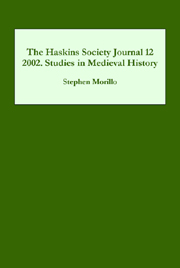Book contents
- Frontmatter
- Contents
- Editorial Note
- Abbreviations
- 1 Religious Houses and the Laity in Eleventh- to Thirteenth-Century England: An Overview
- 2 Two Yorkshire Historians Compared: Roger of Howden and William of Newburgh
- 3 The Rise and Fall of the Anglo-Saxon Law of the Highway
- 4 Consilium et Auxilium and the Lament for Æschere: A Lordship Formula in Beowulf
- 5 Royal Succession and the Growth of Political Stability in Ninth-Century Wessex
- 6 From Anglorum basileus to Norman Saint: The Transformation of Edward the Confessor
- 7 St þorlákr of Iceland: The Emergence of a Cult
- 8 Reshaping the Past on the Early Norman Frontier: The Vita Vigoris
- 9 The Appeal to Original Status in the Angevin Region (Eleventh–Twelfth Centuries)
- 10 Dudo of St. Quentin as an Historian of Military Organization
7 - St þorlákr of Iceland: The Emergence of a Cult
Published online by Cambridge University Press: 12 September 2012
- Frontmatter
- Contents
- Editorial Note
- Abbreviations
- 1 Religious Houses and the Laity in Eleventh- to Thirteenth-Century England: An Overview
- 2 Two Yorkshire Historians Compared: Roger of Howden and William of Newburgh
- 3 The Rise and Fall of the Anglo-Saxon Law of the Highway
- 4 Consilium et Auxilium and the Lament for Æschere: A Lordship Formula in Beowulf
- 5 Royal Succession and the Growth of Political Stability in Ninth-Century Wessex
- 6 From Anglorum basileus to Norman Saint: The Transformation of Edward the Confessor
- 7 St þorlákr of Iceland: The Emergence of a Cult
- 8 Reshaping the Past on the Early Norman Frontier: The Vita Vigoris
- 9 The Appeal to Original Status in the Angevin Region (Eleventh–Twelfth Centuries)
- 10 Dudo of St. Quentin as an Historian of Military Organization
Summary
The year 2000 was a year of celebrations in Iceland marking the 1000th anniversary of the adoption of Christianity. The conversion in Iceland is believed to have taken place in 999 or 1000 in the reign of King Ólafr Tryggvason of Norway and fully confirmed in the reign of his successor Ólafr Haraldsson, whose sainthood was acknowledged soon after his death in 1030. Several sources contain information about the process of Christianisation in Iceland, the oldest being the Book of the Icelanders (Íslendingabók) by Ari þorgilsson from 1125–30. The book is a concise history of Iceland from the beginning of the settlement until c. 1120. The sources and transmission of Ari's account can be traced to the time of the conversion. Ari says in his book that his account of the acceptance of Christianity was how his informant and teacher, Teitr Ísleifsson, had told it. Teitr was the son of Ísleifr, the first bishop of Iceland. Ísleifr was the son of Gizurr Ísleifsson, a Christian chieftain who was present at that dramatic Althing meeting when the new religion was accepted. The accounts of the adoption of Christianity are extensive and lively compared to other chapters of the Book of the Icelanders. It describes how the heathens and the followers of the missionaries almost went to war with each other. Due to a clever speech by the heathen lawspeaker, peace was restored and a law passed saying that the populace should be Christian.
- Type
- Chapter
- Information
- The Haskins Society Journal 122002 - Studies in Medieval History, pp. 121 - 132Publisher: Boydell & BrewerPrint publication year: 2003



